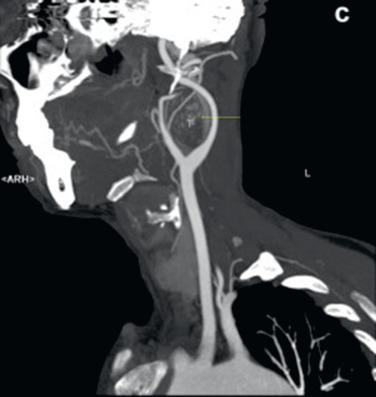Physical Address
304 North Cardinal St.
Dorchester Center, MA 02124
Carotid body tumors (CBTs) are rare and usually benign neuroendocrine neoplasms that have a predictable but slow growth rate and a low potential for malignancy. They arise from the carotid body, which functions as the body's sensor, primarily to O 2 partial pressure. Through afferent fibers of the glossopharyngeal nerve, the carotid body transmits information to the central nervous system. The carotid body is made up of a small cluster of chemoreceptor cells, located near the bifurcation of the carotid artery, which detect not only changes in pO 2 but also CO 2 , pH, and temperature in the arterial blood flowing past it. It is composed of two types of glomus cells, type I (chief) cells and type II (sustentacular cells); chief cells are derived from neural crest and release neurotransmitters, including acetylcholine, adenosine triphosphate, and dopamine, while type II cells function as a supporting structure. Due to its function, the carotid body contains some of the most vascular tissue in the body.
A paraganglioma is a neuroendocrine neoplasm arising from chemoreceptor cells. While the term “paraganglioma” is the most widely accepted to describe these tumors, they were previously called chemodectomas. Over 85% of paragangliomas develop in the abdomen, while 13% develop in the chest, and only 3% develop in the head and neck region; 95% are benign.
CBTs are the most common of the head and neck paragangliomas and are located exclusively in the carotid bifurcation. Other sites in the neck where the paragangliomas may occur include the parasympathetic and sympathetic nerves. When neoplasms arise in these locations, they are often called glomus tumors, and although they behave in a similar clinical pattern to CBTs, they are not CBTs.
Approximately 75% of paragangliomas are sporadic, while 25% are hereditary ( Table 22.1 ). They more commonly occur in patients living at a high altitude. Succinate dehydrogenase gene mutations have been found among families with a high incidence of head and neck paragangliomas and CBTs. Power and colleagues recently demonstrated that mutations in the succinate dehydrogenase gene are highly correlated with a family history of CBTs as well as bilateral CBTs. Specific mutations of the succinate dehydrogenase genes have been associated with increased risk of malignant paragangliomas. Patients with succinyl dehydrogenase (SDH)-positive tumors more often have bilateral, functional, malignant, systemic, recurrent, and metachronous tumors.
| Patient Characteristics | Mean ± SD (Range) or No. (%) |
|---|---|
| Age | 51.2 ± 14.5 (range, 20–84) |
| Female | 257 (72.2%) |
| Ethnicity | |
| White/Caucasian | 138 (38.8%) |
| Black/African American | 9 (2.53%) |
| Asian/Pacific Islander | 16 (4.49%) |
| Hispanic/Latino | 149 (41.9%) |
| Unknown | 44 (12.4%) |
| Family history of CBT | 23 (6.46%) |
Most patients diagnosed with a CBT initially have minimal symptoms, so the most common finding in the early stages is a painless neck mass. It is often discovered by the patient or after a thorough physical exam. As the neck mass enlarges, it becomes more painful, and with gradual enlargement specific nerve compression may lead to neck or jaw pain, facial droop, or voice hoarseness.
Imaging is the best method of diagnosis, starting with duplex ultrasound, which identifies the typical finding of a mass in the carotid bifurcation with “splaying of the carotid arteries.” Duplex ultrasound can also determine the location of the mass with respect to other structures, such as the thyroid, and whether the mass shows the high degree of vascularity present in CBTs. Because of its vascularity, a needle biopsy should never be performed on a CBT. Many surgeons will proceed with treatment based solely on the duplex ultrasound results, although large CBTs—those encasing the internal carotid artery (ICA) and those close to the base of the skull—may need additional imaging.
For most patients, the next diagnostic study is a computed tomography (CT) scan, which is often performed with contrast, and which provides significant additional information ( Fig. 22.1 ). The tumor's vascularity, size, relationship to the carotid arteries and base of the skull, and its intracerebral cross circulation can all be assessed with a CT angiogram. In addition, balloon occlusion can be performed to determine the impact of clamping and/or ligating the carotid artery. Preoperative embolization can be used before surgery to reduce bleeding during resection. As an alternative, a magnetic resonance imaging or magnetic resonance angiography can substitute for the CT scan, particularly if other pathology is suspected. An angiogram is rarely needed in CBT patients, unless embolization or carotid balloon occlusion is being performed. The imaging tests performed should be done in a systematic fashion with an algorithm approach used to limit the number and types of imaging studies.

Become a Clinical Tree membership for Full access and enjoy Unlimited articles
If you are a member. Log in here